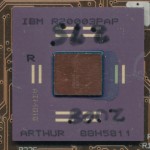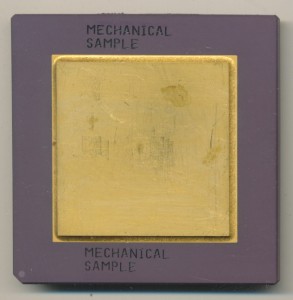July 26th, 2013 ~ by admin

IBM Arthur Processor – 1997
By 1997 the PowerPC 604e was getting a bit dated. Apple needed an updated faster processor for their new computers and IBM and Motorola needed a new processor to sell to Apple. The PowerPC 750 was an evolution of the 604e and became the core of Apple’s various G3 systems.
In early 1997 Apple , IBM, and Motorola (together known as the AIM Alliance) were working on what would become the PowerPC 750. It’s code name? The Arthur. Apparently someone at IBM or Motorola had a liking for Sherlock Holmes as the 745 was codenamed Conan and the 755 Doyle, after Sir Arthur Conan Doyle, writer of Sherlock Holmes. This particular part is date coded R20003PAP which means it was made in mid-May of 1997, 6 months before the G3 and PowerPC 750 were officially released.
The card the Arthur processor (hand labeled 300Mhz) resides on is an Apple Prototype known as the Goleta. The Goleta was one of the first Apple G3 products. It was to be used in the PowerMac 9700 aka the PowerExpress which was to be a 6 slot G3 PowerMac running at 275MHz.

Apple Goleta G3 Prototype – Click here to see the full card.
It never made it past the prototype stage. The card is labeled as serial #014 making it a very early prototype, though how many total were made is not known. The card may have been used at Apple for testing other deigns as well and certainly was a test bench for the new 750 PowerPC Processor. This was a chaotic time for Apple as they were struggling to pull out of near bankruptcy. Steve Jobs had only just returned to the company and radically changed what Apple was doing, and what they were not doing (making money).
July 21st, 2013 ~ by admin

Intel Pentium Mechanical Sample – 1994
Intel and other processor companies spend a vast amount of time testing a processor design before it is released. They want to be sure that it meets the specifications set forth in the datasheets and is free of undocumented errata. Intel gained fame, or notoriety for the FDIV bug int he original Pentiums that caused a certain set of floating point calculations to result in an incorrect answer. This led to the recall and replacement of many millions of processors.
Operational testing however is only one part of the testing a processor undergoes. The package itself must also be tested. It is tested for proper fit and function in a socket and with a variety of cooling apparatuses. Its thermal characteristics must also be tested. The original Pentiums were a ceramic package but quickly moved to a package with a heatspreader as they ran very hot. In additional sample are made for testing the electrical supply of the mainboard, so that mainboard manufacturers may test their VRM (Voltage Regulation Module) design to ensure it can meet the demands of the processor.
A Mechanical Sample, like the early Socket 5 Pentium above, were used to test heatsinks, sockets, and other tasks that did not require a functioning chip. Usually these samples did include a die (as does this one) they just are pulled from the line before final testing and speed binning. Mechanical Samples were also used by Intel in their ‘The Journey Inside: The Computer’ education kits which typically included a processor sample, a wafer and some cut processor dies as well as some basic electronics for students to conduct experiments with. Sometimes Mechanical Samples are devoid of marking, or like this one clearly state what they were intended for. Some processor companies also made Marketing Samples, which were non-functioning, but often marked with color logos/graphics to advertise the processor. Both are ivery rare to find as they were made in very limited quantities and were not widely distributed.




